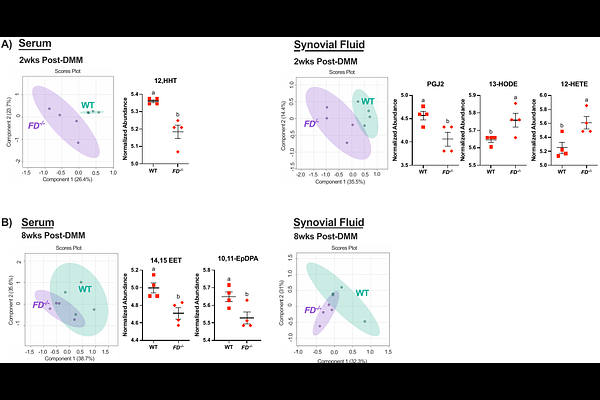Complement factor D (adipsin) mediates pressure-pain hypersensitivity post destabilization of medial meniscus injury

Complement factor D (adipsin) mediates pressure-pain hypersensitivity post destabilization of medial meniscus injury
Tjandra, P. M.; Andoko, B. A.; Kim, J. A.; Gomez, A. G.; Sar, S.; Aepala, M. R.; Pham, T. T. K.; Dumlao, D.; Welhaven, H. D.; Collins, K. H.
AbstractBACKGROUND Although osteoarthritis (OA) is the leading cause of pain and disability worldwide, there is a lack of models to probe the separable mechanism of OA structural damage and knee pain. We previously identified that deletion of complement factor D (FD) results in increased pressure-pain hyperalgesia despite cartilage protection after destabilization of the medial meniscus (DMM) surgery. However, how these discordant OA phenotypes manifest is not understood. We employed a novel targeted lipidomics approach to elucidate the role of eicosanoids in FD-mediated pain. We hypothesize that the absence of Cfd (FD-/-) will protect cartilage but cause increased pressure-pain hyperalgesia and eicosanoid dysregulation that persists throughout OA development. METHODS Male and female FD-/- and wild-type (WT) mice were challenged with DMM or remained naive (n=5-11/group) at 16 weeks old. Pressure-pain hyperalgesia was measured bi-weekly for 8 weeks post-DMM. A second cohort was evaluated at 2 weeks post-DMM (n=6-10/group) to investigate DMM injury response. Structural damage was scored using the Modified Mankin system. To determine changes in eicosanoid profiles, serum and synovial fluid samples were analyzed via liquid chromatography-mass spectrometry (LC-MS). Statistical analysis was performed with unpaired t-test, two-way, or three-way ANOVA with Sidaks posthoc test. Statistical significance is defined as p<0.05. RESULTS In contrast to WT mice, FD-/-showed no significant differences in Modified Mankin scores 8 weeks post-DMM. As expected, FD-/- hyperalgesia levels persisted until 8 weeks post DMM, similar to WT. Changes in eicosanoid profiles of pain-associated factors in FD-/- when compared to WT were found in the synovial fluid at 2 weeks and the serum at 8 weeks post-DMM. CONCLUSION The absence of Cfd drives knee hyperalgesia in male and female mice at 2 weeks-post DMM and persists through an 8-week observation period despite observing cartilage protection. Changes of eicosanoid profiles at both time points suggest that FD drives pain acutely, and the hyperalgesia phenotype emerges early in response to DMM injury, elucidating the role of the alternative complement in mediating OA pain and structural damage.